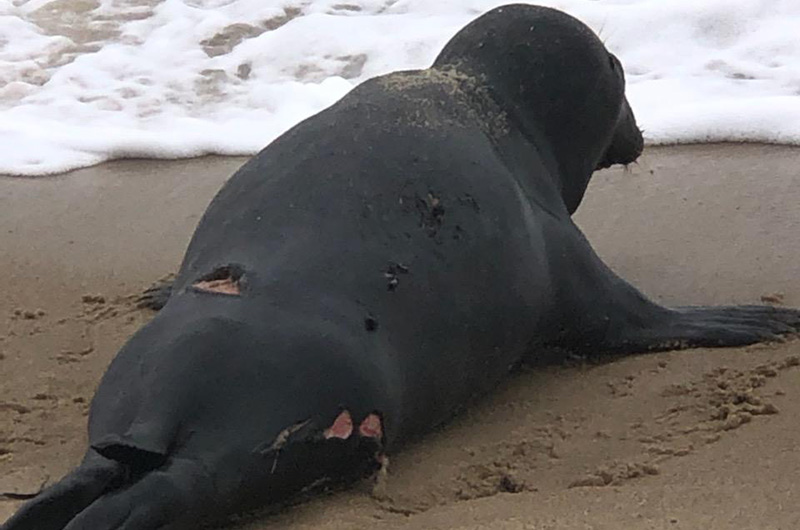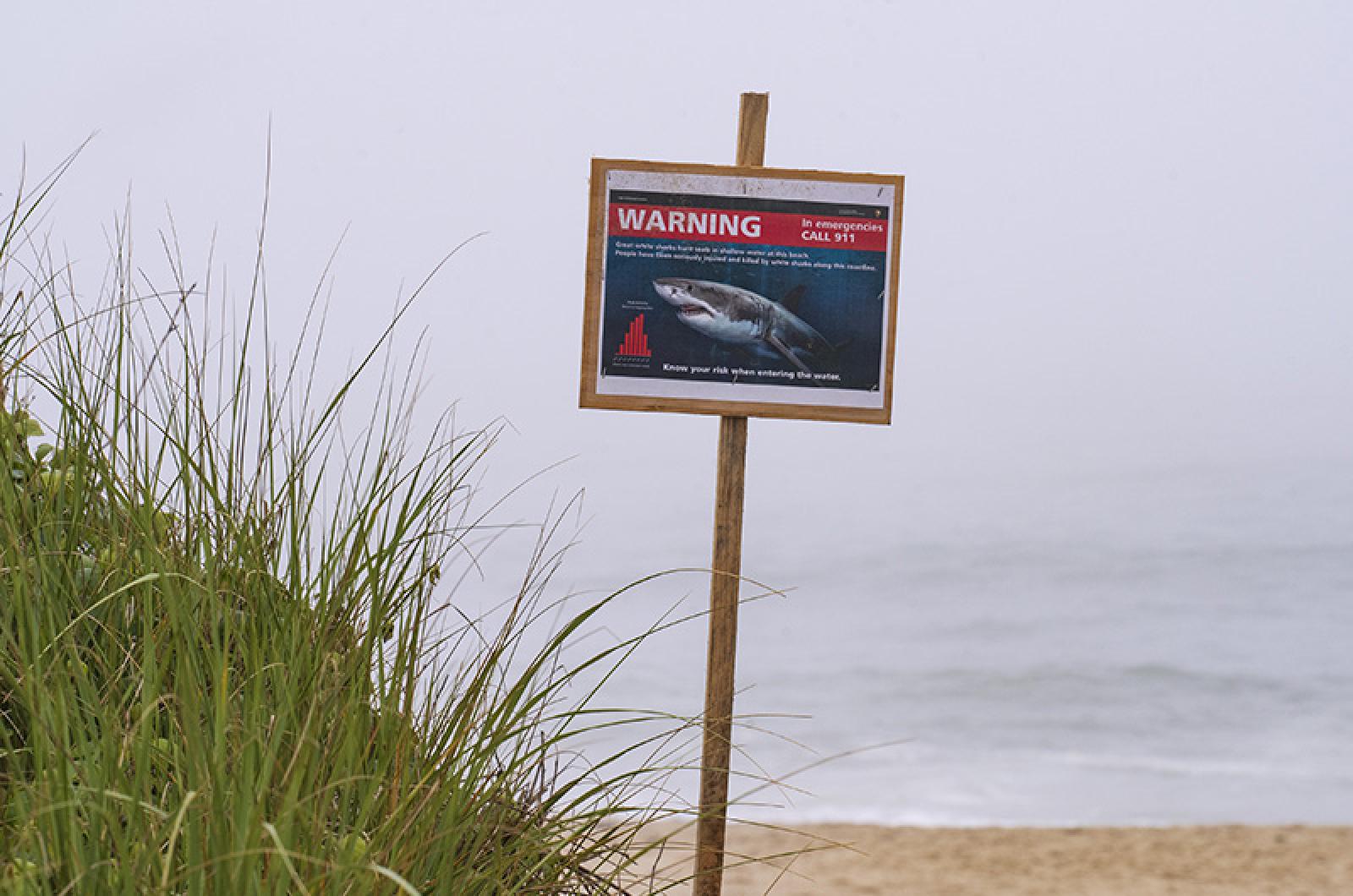Three seals with markings indicative of shark bites have hauled up on the Vineyard’s south shore in recent weeks, prompting calls for caution from Island beach managers and a renewed interest in the changing ecology of the ocean’s most fearsome predator.
“In the case of marine mammals, there’s really only a handful of species in the world that will attempt to kill a seal,” said Dr. Greg Skomal, a marine biologist and the recreational fisheries program manager for the state’s Department of Marine Fisheries. “And in our neck of the woods, it really would only be a white shark, a great white.”
Island officials have also reported numerous other unconfirmed shark sightings this summer, including a shark spotted at Wasque that caused a temporary beach closure this past weekend.
The recent spate of seals washing up on shore with bite marks and wounds began 10 days ago, on July 10, when the Trustees were informed about a seal with signs of obvious shark predation on the beach at Long Point Wildlife Refuge. A photograph of the seal showed bite marks on its posterior and flipper, according to Mr. Skomal and Chris Kennedy, the down-Island stewardship manager for the Trustees.

Mr. Kennedy said the seal was alive when it hauled up at Long Point, and that it remained on shore after the attack.
“The shark just nipped it, really. The seal was very fortunate, it was a close encounter with a great white,” Mr. Kennedy said. “But it was very happy to be on the beach. No one ever said seals were stupid.”
Sam Hart, executive director for the Trustees on the Island, said the beach was closed to swimming for two hours, per Trustees protocol.
Earlier in the month, a dwarf or pygmy sperm whale with injuries was also spotted twice thrashing at the shore of East Beach on Chappaquiddick, according to the Trustees. And Mr. Hart said that a Trustees ranger spotted a fin at Norton Point a few days later.
All three sightings occurred within the span of a week, according to Mr. Hart, prompting the Trustees to put up signs at their beaches warning swimmers to be vigilant and ensuring rangers have tourniquet training.
“We urge all visitors to East Beach to use extreme caution when entering the water, especially if you have seen the ever-present seals which cruise up and down the beach in summer,” a release from the Trustees states.
Then on Monday, Mr. Kennedy said the beach at Wasque was temporarily closed this weekend after a shark fin was sighted by a fisherman at 12:30 p.m. Saturday. Experts could not confirm whether the shark was a sandbar shark or a great white because the shark was underwater in the photograph.
And last week, Mr. Skomal confirmed that two seals had hauled up at Squibnocket beach in Chilmark with bite marks indicating shark predation, although the marks remain unconfirmed because of the poor quality of the photographs.
“We couldn’t definitely say whether they were shark bites, but potentially they were,” Mr. Skomal said. “We’re well aware of the presence of that seal haul-out on Noman’s [a wildlife sanctuary off Chilmark that is off-limits to people].”
Both Mr. Kennedy and Mr. Skomal said that while it isn’t unheard of for wounded seals to haul up on the Vineyard, the frequency of the recent cluster made it striking and unusual compared to years past. And they all pointed to the increased presence of seals in the area as a possible explanation for the peculiar flurry in shark activity and predation near the Island.
Mr. Kennedy said he now sees two or three seals cruising off East Beach on most shoreside drives. Last year, he said it was rare to see even one.
“The reality is that we have many more seals than we had even several years ago,” Mr. Kennedy said. “And it isn’t surprising that there are more shark sightings, so knock on wood.”
Mr. Skomal confirmed that it is rare to find wounded seals washed up on the Vineyard, although he cautioned against pointing to a trend.
“We don’t have a lot of reports of injured seals on the Vineyard. We just don’t,” the longtime shark biologist said. “I don’t know why. I don’t know if this is a relatively new phenomenon, with the sharks spending more time there. Or people just haven’t been there. Or the seals are expanding to the Island in greater numbers. Those are all the factors that can go into that.”
Although the Vineyard still has a much smaller seal population than parts of the outer Cape or Nantucket, the regional population has significantly rebounded from lows in the 1970s and 1980s when the pinnipeds were nearly hunted to extinction, according to scientists. The gray seal is now officially protected through the Marine Mammal Protection Act.
But as the seal population grows around the Vineyard, so too, inevitably, does the population of its only true predator — great white sharks — initiating what in recent years has become a delicate balancing act between conservation and safety.
“A lot hinges on whether you have a predictable presence of seals in the area. That’ll drive some sharks to stay in the area, much like we see on the outer Cape,” Mr. Skomal said. “But we’re talking about more than one or two seals that pop up now again. We’re talking about the presence of a haul out that is consistent and predictable.”
There are now large seal haul outs — the term for a group of seals that literally hauls itself onto the beach — on Muskeget island, which sits about two thirds of the way between the Vineyard and Nantucket, as well as Noman’s Land. The presence of the haul outs aligns with the recent wounded seal sightings.
“It’s like an old restaurant re-opening,” Mr. Skomal said, describing the evolving seal population. “What we’re seeing here in southern New England is the restoration of the seal population. And that’s good. But with the restoration of the seal population, we also have white sharks, which have also been given a level of protection, and which also seem to be rebounding from overfishing — and redistributing in response to the seals.”
Despite the seal sightings, Mr. Skomal was fairly confident that data from three shark receivers along the Vineyard’s south shore indicated that the fish were transiting the area rather than maintaining residency. Although data from 2019 remains unavailable, numbers from 2018 noted five sharks pass a receiver by the right fork in Edgartown, and two sharks pass a receiver by Oyster Pond. Both sharks that passed the Oyster Pond receiver also passed the right fork receiver.
Mr. Skomal has tagged upwards of 200 sharks with acoustic recognition capabilities. Almost all the receivers and the state’s shark sightings occur on the eastern side of the outer Cape. The total shark population remains unknown.
“The detection data that we did get from the receivers so far, is that the white sharks do tend to pass by the south shore of the Island, but they don’t seem to spend any time,” Mr. Skomal said. “They seem to be more transient in their behavior, almost as if they are just moving by to get to the more northern parts.”
Both Mr. Kennedy and Mr. Skomal said that great white sharks have historically always transited the Vineyard waters, with confirmed sightings going back to the 19th century. They added that the resurgence of the seal population is likely a natural process rather than a factor of climate change.
With regard to safety, Mr. Kennedy urged swimmers to show caution, to not swim at night, and to stay close to shore.
Mr. Skomal painted the risk factor in slightly different terms.
“How many people have been killed by mopeds on Martha’s Vineyard?” he said. “Or how about cars. People get in cars every day, and they don’t even think about it. The probability of getting hurt in your car is orders of magnitude higher than getting bitten by a shark.”






Comments (2)
Comments
Comment policy »